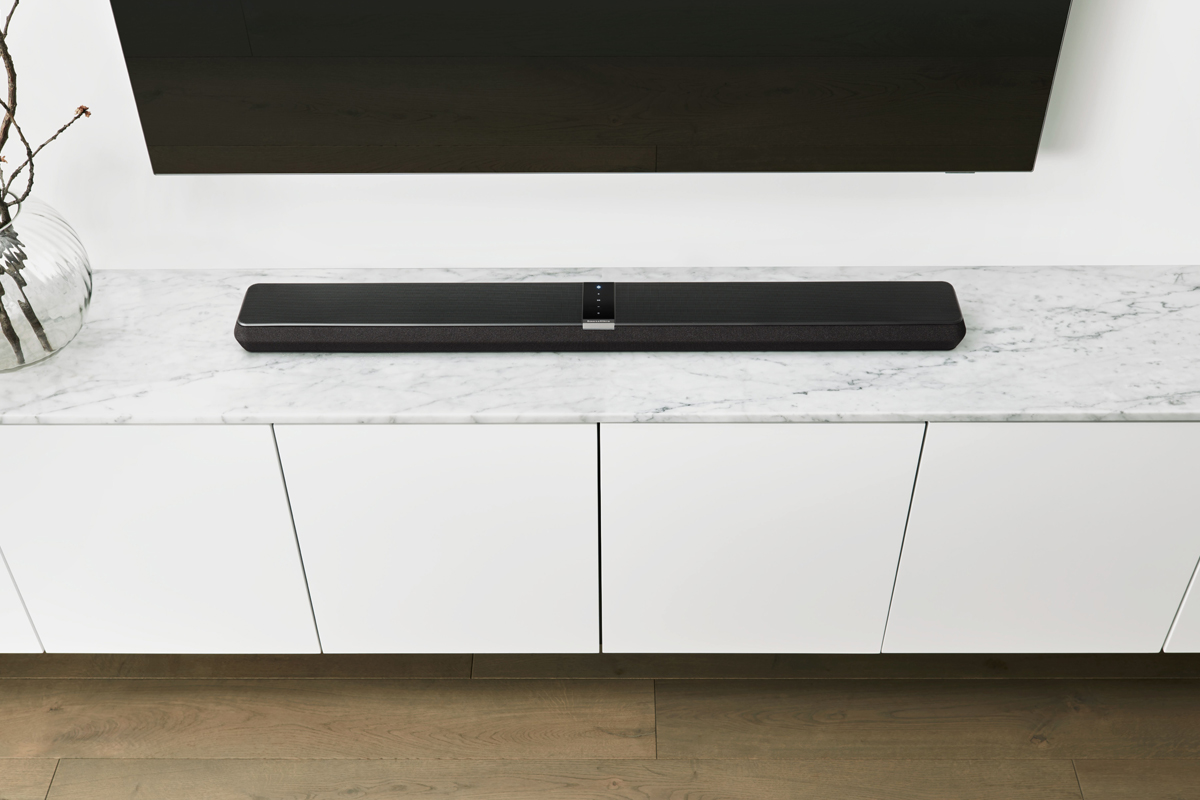To purists and zealots, compromise is a dirty word; but for most of us, compromising is how we get along in life. This is as true of audio as any other pursuit. We can daydream about our ultimate systems, but we have to reconcile those dreams with reality—with our budgets, our living spaces, and the people who share those spaces.
Soundbars are the ultimate compromise components. If you’ve just bought a big UHD TV, you might dream about mating it with a powerful surround-sound system that supports Dolby Atmos immersive audio. You might be able to indulge that dream if you have a dedicated home theater or a large family room; but for smaller spaces and more limited budgets, a soundbar might make more sense. A good soundbar won’t deliver experiences as immersive and visceral as a full-blown surround system, but it will be a huge step up from the built-in TV sound.
Many TV and audio brands now offer Dolby Atmos soundbar systems that can connect wirelessly to matching subwoofers and surround speakers. Bowers & Wilkins’s Panorama 3 soundbar ($999, all prices in USD) is completely self-contained. You can’t add surround speakers or a sub, but as you’ll see, you don’t have to.
The Panorama 3 delivers 3.1.2-channel audio: front left, center, and right; a single subwoofer channel (produced by two bass drivers); and two height-effects channels produced by drivers that bounce sounds off the ceiling. For movies and TV, the Panorama 3 has HDMI eARC and optical S/PDIF (TosLink) inputs for connection to an HDTV. For music, the soundbar has a built-in network streamer that supports Apple AirPlay 2 and Spotify Connect. The Panorama 3 also works with the companion Bowers & Wilkins Music app, which has integrated support for several streaming services. And it can function as an Amazon Alexa smart speaker.
Inside and out
The Panorama 3 houses 13 drivers and ten class-D amplifiers that deliver a total output of 400W. For each of the left, center, and right channels, there are dual front-firing 2″ bass-midrange drivers with woven glass-fiber cones and a single 0.75″ titanium-dome tweeter. The height-effects channels are produced by two upfiring 2″ bass-midrange drivers with woven glass-fiber cones, one on either side of the bar. Bass comes from two upfiring 4″ drivers, which B&W calls “subwoofers,” with their own large sub-enclosure. Each “subwoofer,” height-effects speaker, tweeter, and pair of bass-midrange drivers has its own 40W amplifier. Specified frequency response is 43Hz–48kHz; no deviation spec is provided.
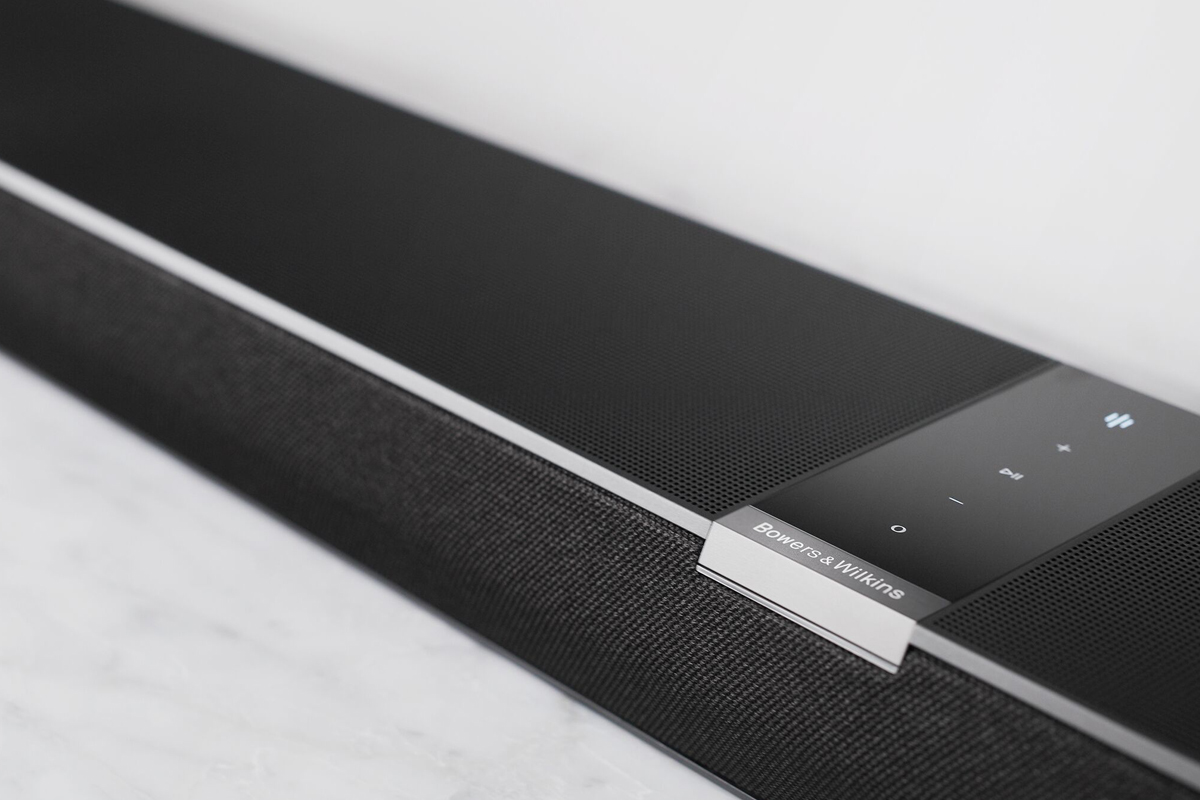
Measuring 48″W × 2.6″H × 5.5″D and weighing 14.3 pounds, the Panorama 3 will fit nicely underneath TVs 50″ and larger. It can be placed on a shelf or fastened to the wall. There are inserts for wall-mounting on the back of the soundbar, and a mounting kit is included in the box. Also included are a 2m (6.5′) AC cord and 1m (39″) HDMI cable.
Like the Ford Model T, the Panorama 3 is available in one color: black. The front and sides are covered in a black, coarse-weave grille cloth. A perforated black, metal grille covers most of the top panel, in the center of which is a dark-glass touch panel with a silver-colored metal front edge. It has controls for volume, playback, and activating the Alexa voice assistant. The Multifunction button at the top is used for cycling through inputs; it also illuminates in different colors to indicate system status.
On the connection strip on the back panel are a reset button, an optical S/PDIF (TosLink) input, a USB Type-C service port, the two-prong AC inlet, an ethernet port, and the HDMI ARC/eARC input. Note that the Panorama 3 only has one HDMI port. If you want to use multiple A/V sources (disc player, game console, media adapter, etc.), these have to be connected to the TV, which will then send audio from the selected source to the soundbar.

You can also use the Panorama 3 for music. It has Bluetooth capability, with support for the aptX Adaptive, AAC, and SBC codecs, as well as built-in Wi-Fi. The Panorama supports Apple AirPlay 2, so you can stream audio from any app on an i-device, Macintosh computer, or an iTunes library on a Windows PC. Spotify Connect is also supported, so you can cue up music in the Spotify app, then transfer playback to the soundbar. The companion Bowers & Wilkins app has integrated support for Deezer, Qobuz, SoundCloud, Tidal, and TuneIn internet radio.
Setup and software
The Panorama 3 comes with a rudimentary Quick Start Guide that should be enough to get you started, but it’s definitely worth downloading the full manual.
I placed the Panorama 3 on the mantle of the electric fireplace in our basement family room, directly underneath a wall-mounted 50″ Samsung Frame TV. The soundbar was 7′ from my listening position on a small sofa on the opposite wall. I connected the B&W bar to the HDMI eARC port on the One Connect breakout box for the Frame TV.
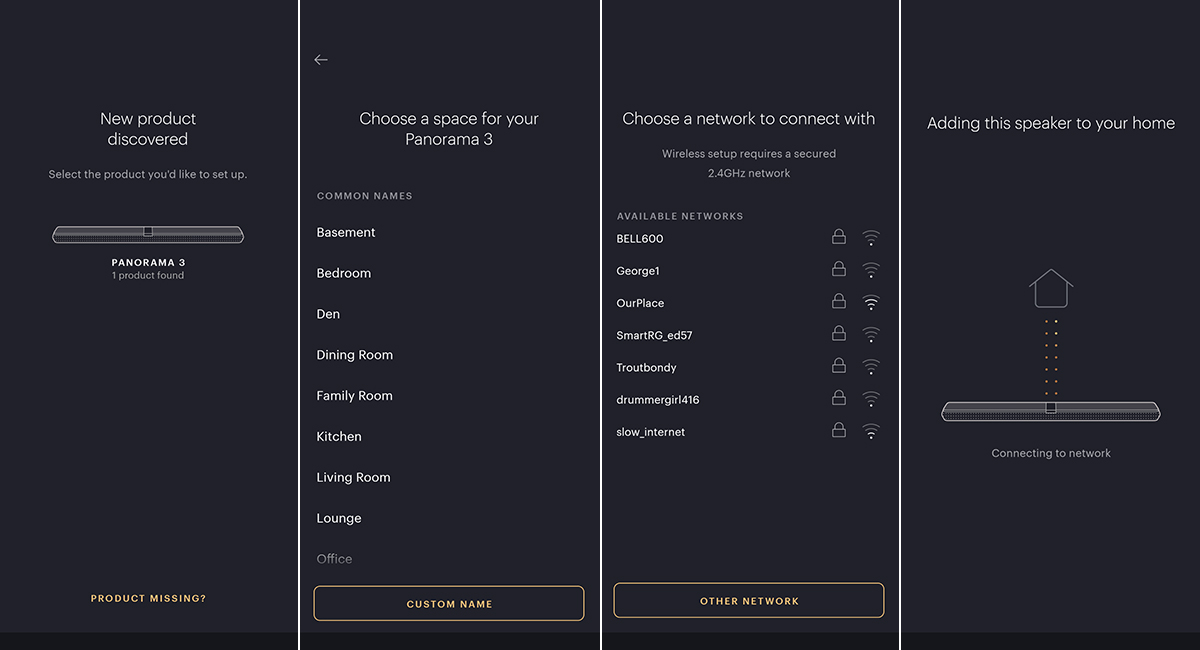
Before the Panorama 3 can be used, it must be set up in the Bowers & Wilkins Music app. The Quick Start Guide has a QR code that will take you to a B&W web page with links to the Apple App Store and Google Play. After installing and launching the app, you’ll be invited to create a Bowers & Wilkins account, or sign in if you already have one. After I had done that, the app found the soundbar, asked me to name it, and prompted me to press the Multifunction button on the top panel of the bar. After selecting my Wi-Fi network from the list of available networks and entering my password, I was prompted to press the volume-up button on the TV remote. The app didn’t detect the remote, but that may be because of the way the Samsung TV implements the HDMI CEC protocol. I just skipped this step, and everything worked fine. Now the bar was ready to use.
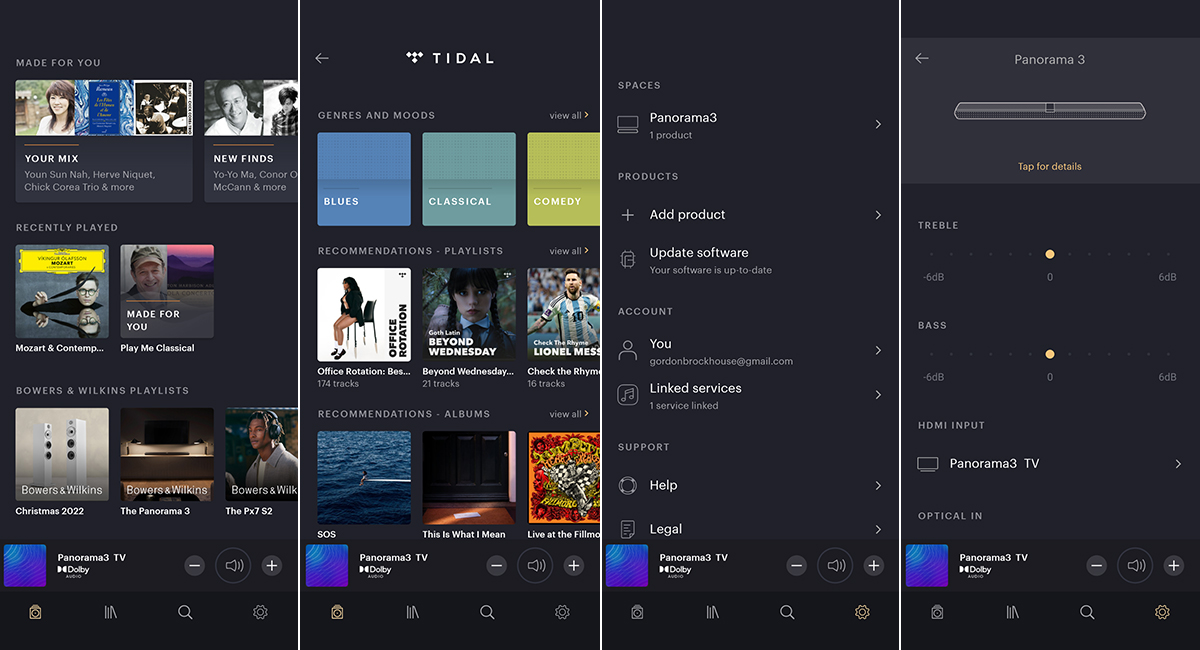
In the Settings menu of the B&W Music app, you can adjust bass and treble, rename inputs, and update firmware. You can also use the app to stream music to the Panorama 3 from supported streaming services. Qobuz isn’t available in Canada, where I live, so that option did not appear in the app. I did access Tidal from the Bowers & Wilkins app, which I found a tad awkward to navigate. Given the fact that this is an Atmos soundbar, it would have been nice to use the Bowers & Wilkins app to stream Dolby Atmos tracks from Tidal, but that’s not possible.
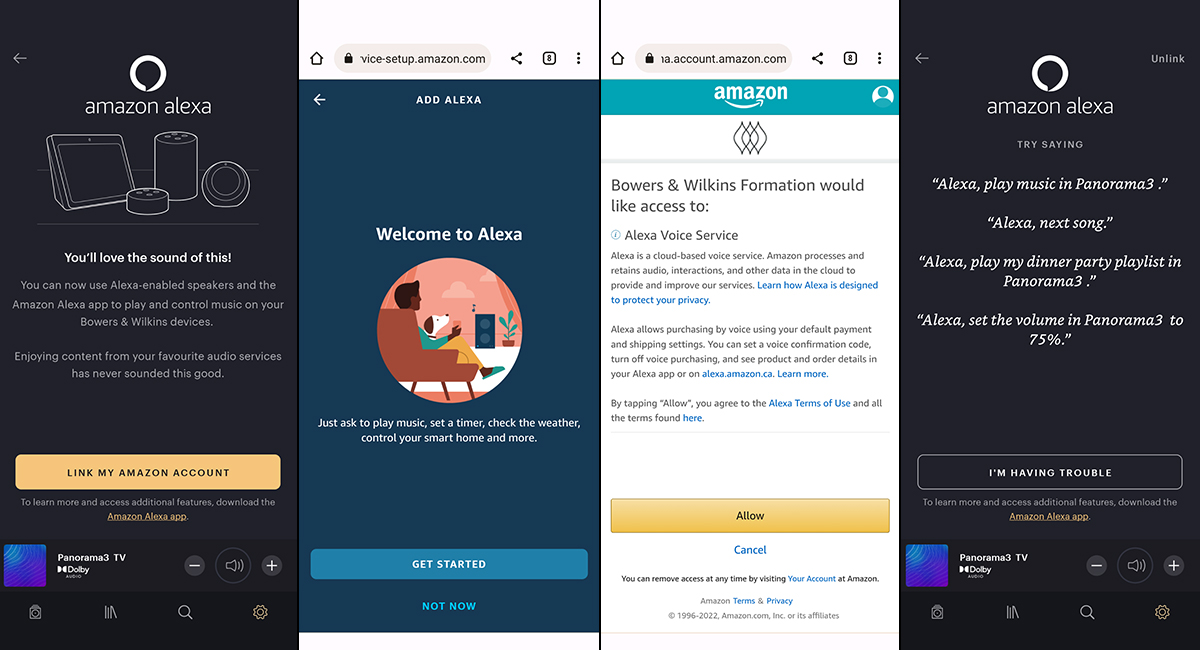
The Settings menu also lets you link the Panorama 3 to your Amazon account and set it up as an Amazon Alexa smart speaker. The Panorama was very effective at detecting the trigger phrase. Even if I was playing music or a movie with the volume set very high, as soon as I said “Alexa” the soundbar’s volume setting automatically dropped, and Alexa responded to my command. One annoyance: the Panorama 3 acknowledges Alexa commands at the same volume you were last using for music or movie playback. If you’ve set volume at a high level, Alexa will respond in a loud voice. If it’s set very low, Alexa will respond quietly. It would be nice if you could set a default level for Alexa responses, but I could find no such setting in the B&W Music or Alexa apps.
Movies and TV
For movie and TV viewing, I used the Netflix, Amazon Prime Video, Apple TV, and Crave TV apps on the Frame TV. (Crave TV is a Canadian streaming service that offers HBO and Showtime as optional add-ons.) With Dolby Digital and Dolby Atmos content, the Panorama 3 delivered impressively immersive listening experiences. The soundstage extended far beyond the outer edges of the soundbar, and far out into the room—as long as I was sitting in the sweet spot. If I stood, or moved off-axis, the soundstage collapsed to the area right around the bar. All my remarks are based on listening in the sweet spot. Even in the sweet spot, the sensation of sounds coming from above was not as convincing as with other Atmos systems I’ve heard.
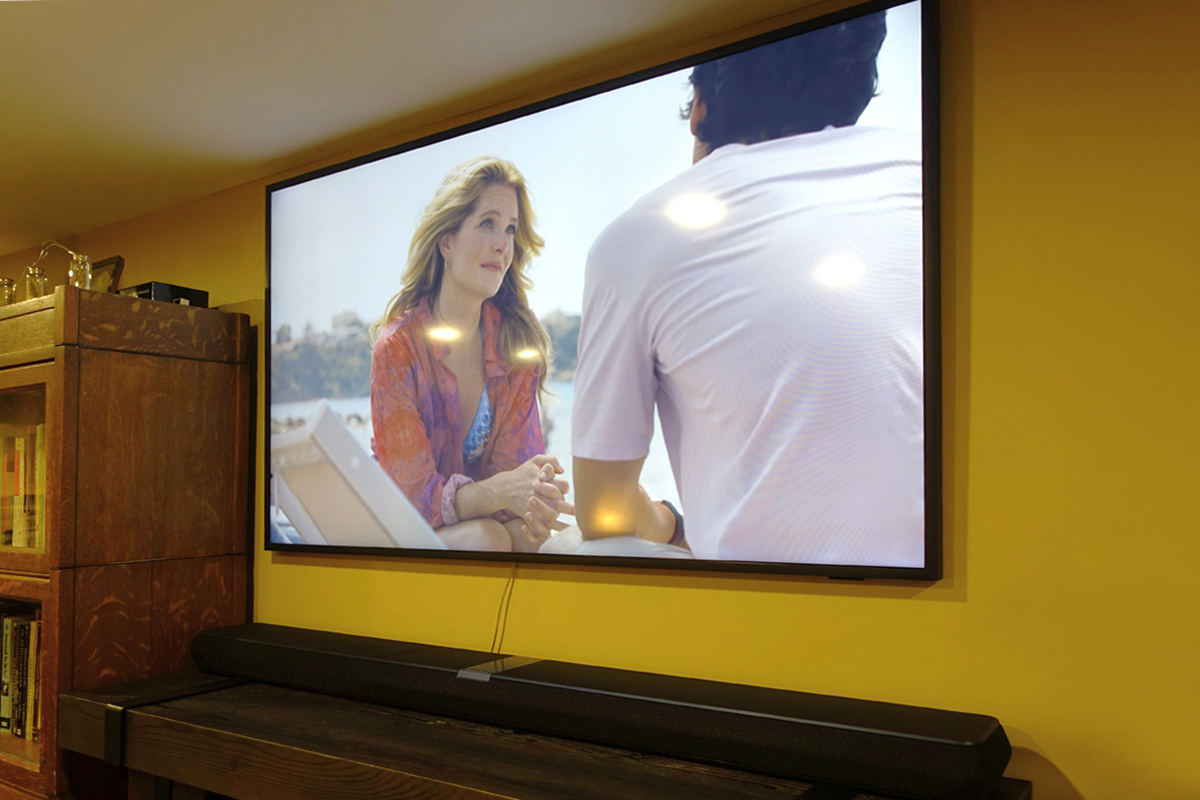
Like almost everyone in the English-speaking world, I got hooked on season 2 of The White Lotus, which has a fantastic Dolby Digital soundtrack. Shortly after the beginning of the season finale, there’s a scene during which Ethan (Will Sharpe) is lying awake in bed, wondering if his wife Harper (Aubrey Plaza), who is asleep, has cheated on him with his friend Cameron (Theo James). Accompanying the scene is “Dido’s Lament,” from Henry Purcell’s opera Dido and Aeneas. Through the Panorama 3, Joyce DiDonato’s intense soprano voice sounded gorgeous—full, embodied, and uncolored. The baroque strings sounded a little thin, but the lute was wonderful—rich and woody.
Throughout the episode, the musical soundtrack extended far out to the sides and out into the room. At many points in the series, deep synth notes and pounding bass-drum beats signal a menacing turn in the plot. While these elements weren’t as deep and powerful as I’d have liked, they were mighty impressive, considering the Panorama 3’s compact form factor.
Dialog was crisp and intelligible, though voices had a slightly papery edge. Dialog was tied to the screen, with convincing reverberation that matched the surroundings.
Foley effects—crashing waves, screeching seagulls, songbird calls, chirping insects, motor scooters, the sounds of diners in the hotel restaurant, crowds in an Italian plaza—were very convincing. Some of these sounds seemed to emanate from locations as far as 10′ from the soundbar—far to the side and out into the room. In the climactic scene, when Tanya (Jennifer Coolidge) shoots the characters who are trying to kill her off, I could hear the shell casings falling down to the floor. And when she is drowning, I could hear the seawater swirling all around the soundstage. The whole experience was completely immersive.
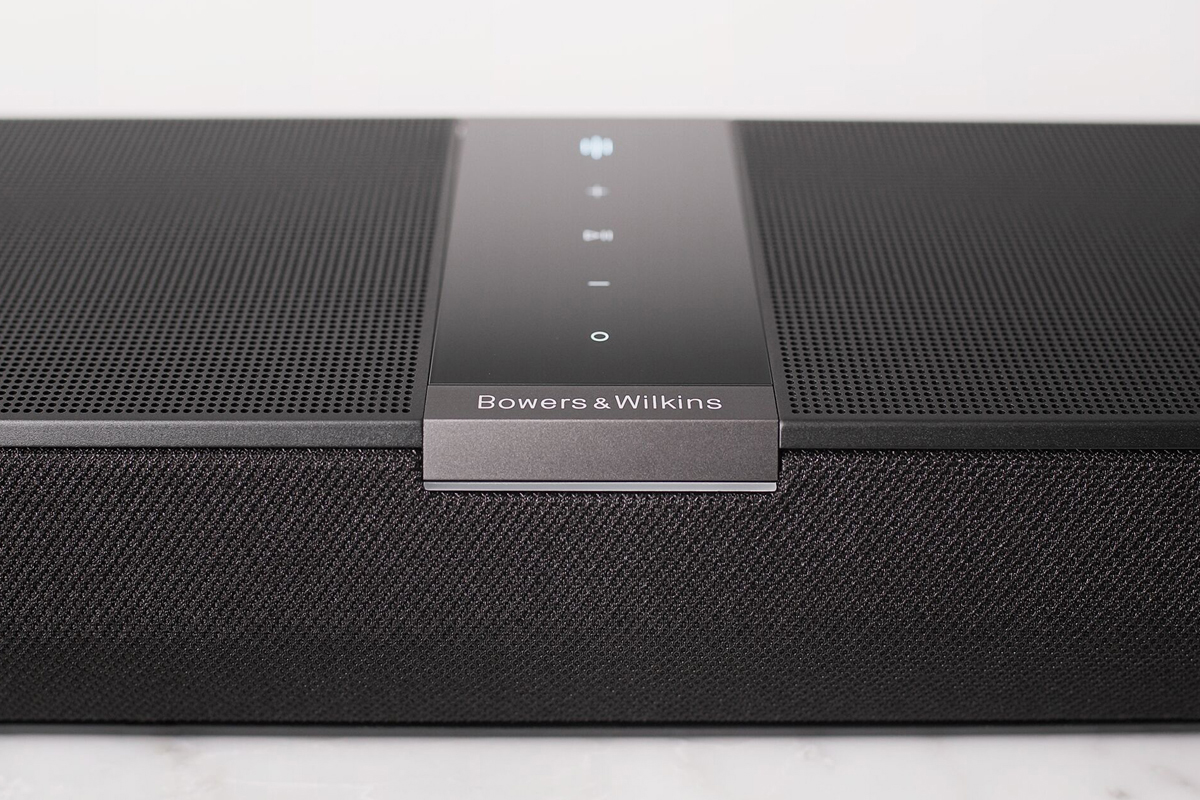
Wanting to experience an epic movie with a Dolby Atmos soundtrack, I cued up David Michôd’s The King (2019) on the Frame TV’s Netflix app. Again, dialog was clear and tied to the screen, but voices had a slightly hollow quality and papery edge, and male voices sounded a little thin.
In the scenes inside medieval castles and inns, background sounds like barking dogs and crying babies extended 10′ or more off to the sides and out into my room, almost to the base of my sofa on the opposite wall. Many of these sounds were very precisely located, as if they were coming from the next room or the floor above.
During the storm on the eve of the battle of Agincourt, raindrops seemed to be splashing all around my room, but I did not get the sense of a storm happening overhead. And during the battle, when English longbows rain arrows on the mounted French knights, I could hear the whistle of the arrows, but didn’t have a strong sense that they were coming from above. The Panorama 3 portrayed the chaos of the battle convincingly, with the sounds of weapons clashing, horses neighing, and soldiers screaming coming from all around the room. The sound was somewhat congested, and bass wasn’t as deep as you’d get from a full-blown surround system, so the experience wasn’t as visceral. But it was far better than I expected from a system this size—completely immersive and utterly thrilling.
Music
Most people buy a soundbar for movie and TV viewing. Given its pedigree, I had a strong inkling that the Panorama 3 would perform more than respectably with music, especially with Atmos-encoded spatial audio tracks. And so it proved. For music playback, I played a wide range of spatial audio tracks using the Apple Music app on the Frame TV. I also streamed two-channel tracks from the Roon Core on the Mac Mini in my second-floor home office. The Panorama 3 isn’t Roon Ready, so Roon converted the streams to 16-bit/44.1kHz before sending them to the Panorama via AirPlay.
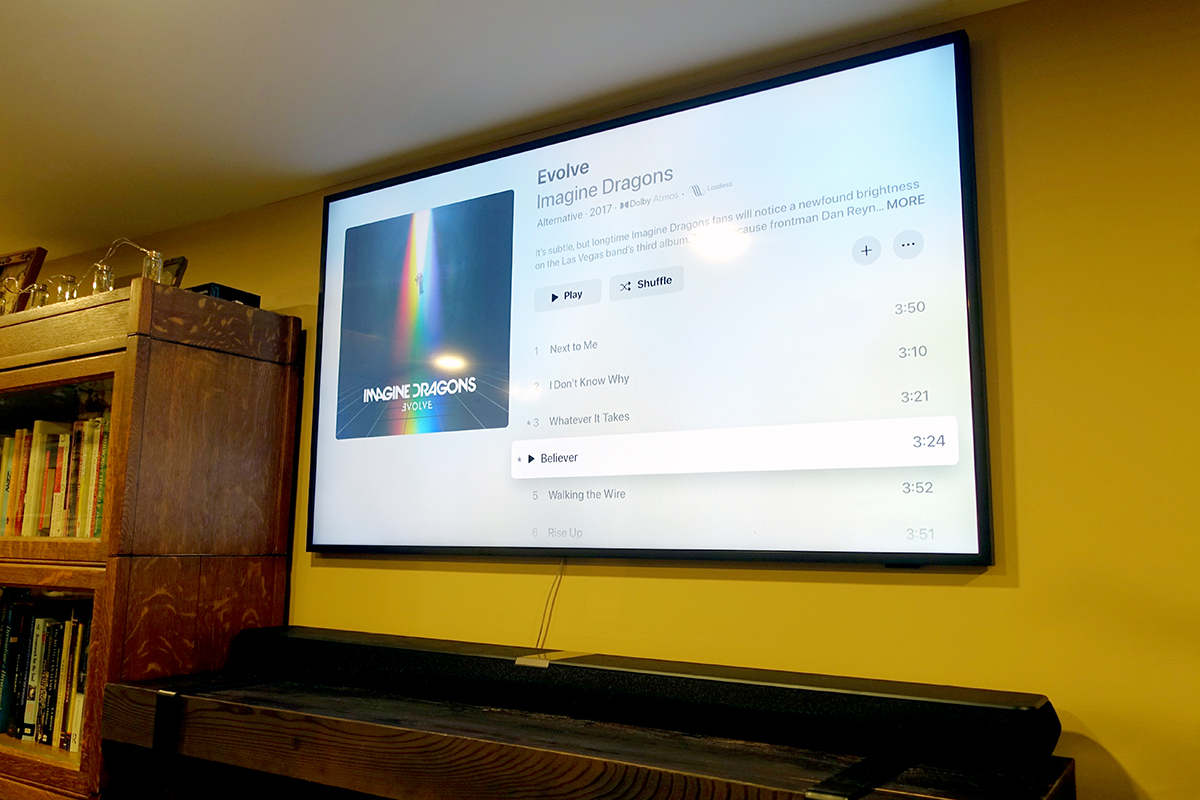
I started with two-channel playback, streaming Imagine Dragons’ “Believer,” from the band’s 2017 album, Evolve (24-bit/44.1kHz FLAC, Kidinakorner / Interscope / Qobuz), to the Panorama 3 via Roon. The huge drum flourish that opens the track pounded way harder than I’d have thought possible from a compact soundbar like the Panorama. Lead singer Dan Reynolds’s voice in the center had a slightly hollow character, and the background vocals in the choruses had a bit of a hard edge. The nylon-strung acoustic guitar had a nice, warm tone but was a tad soft-edged. The soundstage extended a little beyond and above the soundbar—but only a little.
I had a reason for selecting this track. When I interviewed him for a feature on mastering music in Dolby Atmos, veteran UK recording and mix engineer Heff Moraes cited “Believer” as an example of a mix that uses Atmos very creatively. So I cued this song up in the Frame TV’s Apple Music app so I could hear Apple’s spatial audio with Dolby Atmos version.
The soundstage was far wider and higher, extending almost 10′ off to either side, and up to the ceiling. Those big drumbeats were spread across almost the entire width of the room, well above the rest of the mix. Reynolds’s lead vocals in the center had less of the hollow quality I had heard in the stereo mix. And the intense background vocals in the choruses were now clearly behind Reynolds. Subtle percussive effects high on the soundstage that were almost lost in the two-channel mix now stood out. The acoustic guitar was also better differentiated from the rest of the mix.
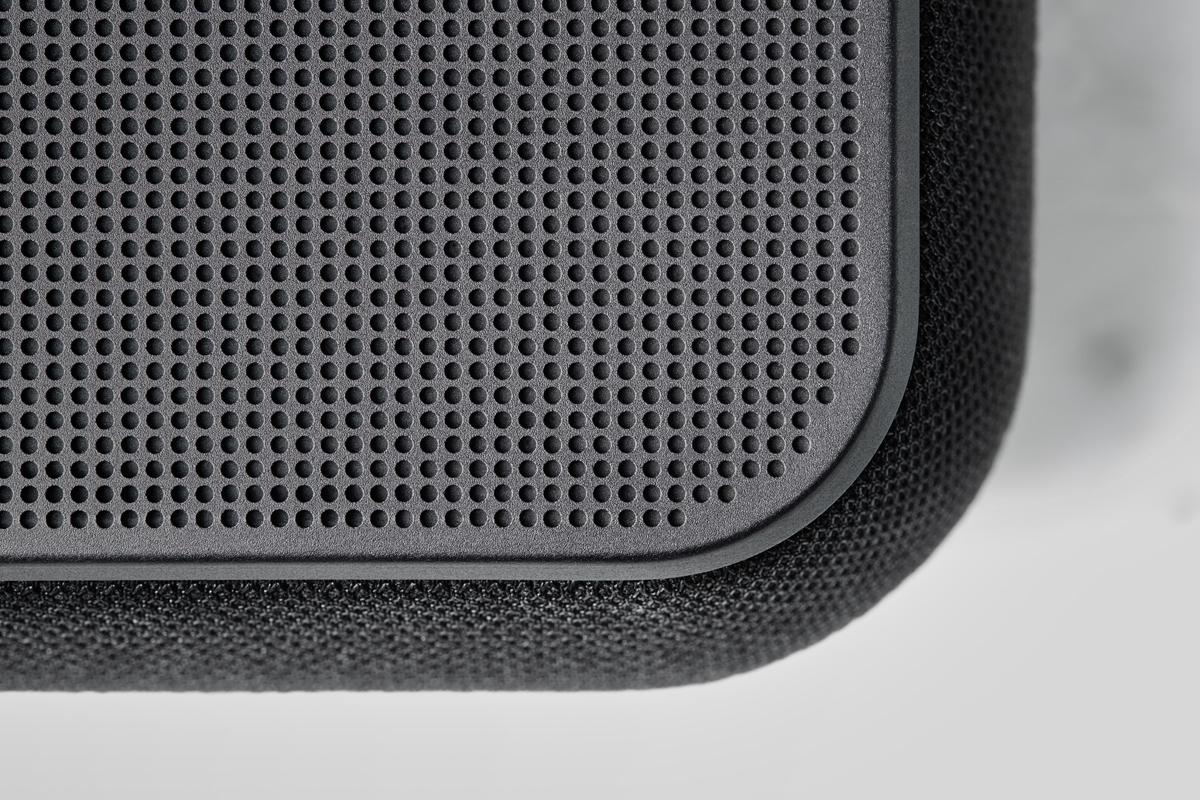
To hear how the Panorama 3 would fare with orchestral music, I streamed a performance of Ravel’s Boléro by the Sinfonia of London, conducted by John Wilson (24/96 FLAC, Chandos Records / Qobuz), from Roon.
Even with the stereo mix, the soundstage extended a little to the sides and above the soundbar. Taking turns playing the main theme at the beginning of the piece, the woodwind instruments—flute, clarinet, bassoon, oboe d’amore, soprano saxophone—had delectable timbre. They seemed to be a few inches above the bar. The quiet rat-a-tat snare drums emerged from a foot or so off to the left and right, but were a little lacking in texture. Later in the piece when brass instruments (trombone, and later trumpet) pick up the melody, I enjoyed their golden, metallic tonality, but wished for a bit more bite. And the pizzicato notes on the double basses sounded thuddy.
Throughout the piece, the soundstage was two-dimensional, with very little front-to-back layering. As the piece builds in intensity, the sound became somewhat hollow-sounding and congested; not surprising given the limitation of the form factor, but still very enjoyable. Despite the congestion, I could easily follow different groups of instruments. Equally important, the Panorama did not sound harsh or distressed, even in the big conclusion when the whole orchestra is playing fortissimo.
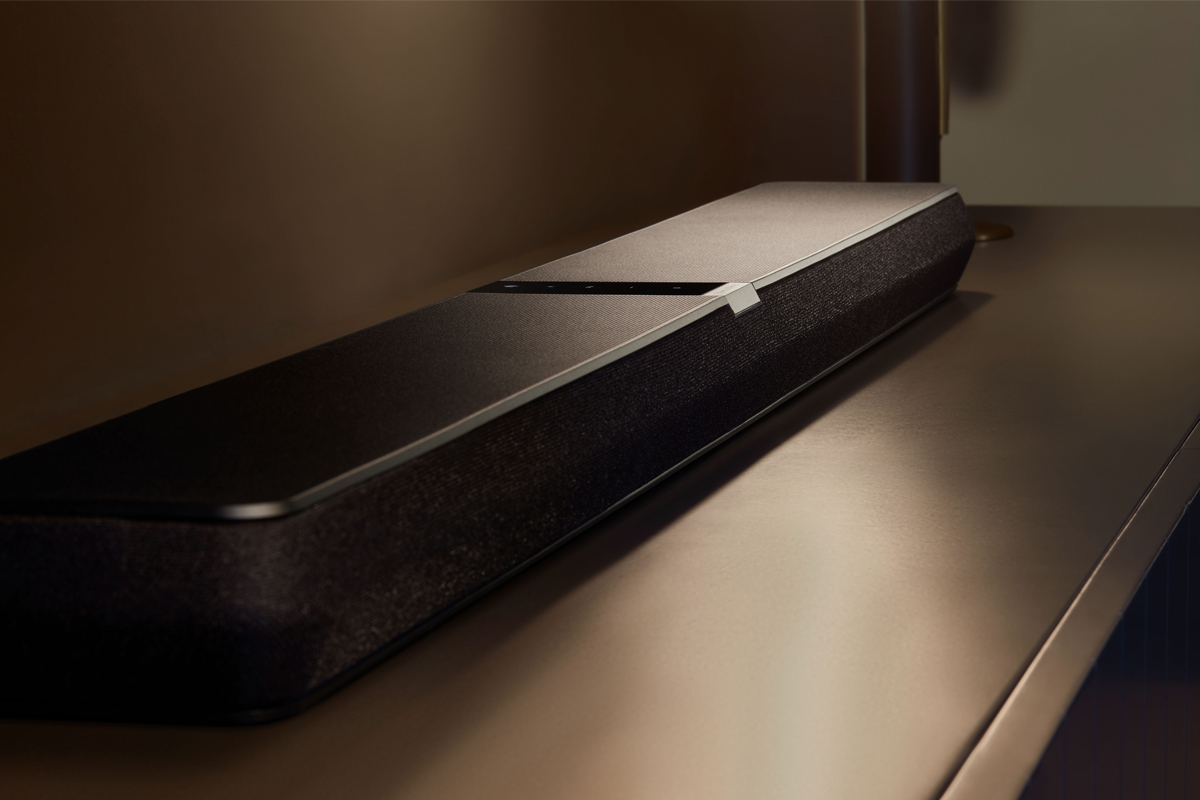
There was a reason for this selection, too: this recording of Ravel orchestral works received a 2022 Gramophone Classical Music Award in the UK classical-music magazine’s spatial audio category. So next, I cued up the work in the Frame TV’s Apple Music app so I could hear the Atmos version.
The soundstage opened up dramatically, extending several feet beyond the soundbar and a couple of feet above. The soundstage now had impressive depth, with much better front-to-back layering. With the Atmos stream, I could hear the reverberation of the orchestra throughout the interior of St. Augustine’s Church, Kilburn, the London church where the recording was made. The woodwinds in the opening section had the delectable tonality I had enjoyed on the two-channel stream, but the thuddiness of the double basses was still present and the brasses still needed more bite. The groups of instruments were separated much more clearly. In the big conclusion, the sound was less congested and dynamically compressed on the Atmos stream, which made it more exciting and involving; but it was also brasher.
Comparison
I didn’t have another soundbar on hand to use as a comparison, but I thought it would be interesting to compare the Panorama 3 with a similarly priced two-channel setup. SVS’s Prime Wireless Pro active speaker system ($899.99) fit the bill perfectly. SVS says the Prime Wireless Pro can be used “as a superior-sounding soundbar replacement.” I’ve read similar claims from other manufacturers for their powered and active compact two-channel speaker systems.
Watching The King, with the Frame TV sending a two-channel PCM downmix to the Prime Wireless Pro’s HDMI input, the big battle scene was not nearly as immersive as it was with the Atmos soundtrack through the Panorama 3; the sound was tied to the screen. While the sound was less dynamically compressed on the SVS system, it was more congested. Effects like clashing weapons, neighing horses, and bellowing voices weren’t as well differentiated as they were with the Atmos soundbar, because they weren’t as well separated spatially. However, the Panorama 3 had a bit of a hard edge that wasn’t present on the Prime Wireless Pro. The low synth notes in the score sounded a little fuller through the SVS speakers; voices were more embodied and had less of the papery edge I noticed with the Panorama 3. But the soundbar delivered a far more immersive experience.
Playing Ravel’s Boléro through the SVS system, the soundstage was confined to the space between the speakers, but front-to-back layering was much better than it was through the soundbar playing the two-channel stream from Roon. Microdetail was better—I could hear the expressive touches by the woodwind soloists more clearly with the SVS speakers than I could with the Panorama, either with the stereo or the Atmos stream. Bass definition was better through the SVS speakers—bass drumbeats and timpani had more punch and less thud. The two snare drums had more texture and body. Aural images were more precisely delineated, but the presentation was not nearly as vast as it was with the Atmos version played through the B&W bar. Through the Prime Wireless Pro, the big conclusion sounded a bit congested and brash, but less congested than with the Panorama bar.
Conclusion
Calling a product a great compromise might seem like damning with faint praise. It’s not. In the basement family room of our small Toronto rowhouse, a full surround system would be totally impractical. So would an Atmos soundbar system with separate surround speakers and subwoofer. Even a two-channel setup is a challenge, but the Panorama 3 worked beautifully in this space.
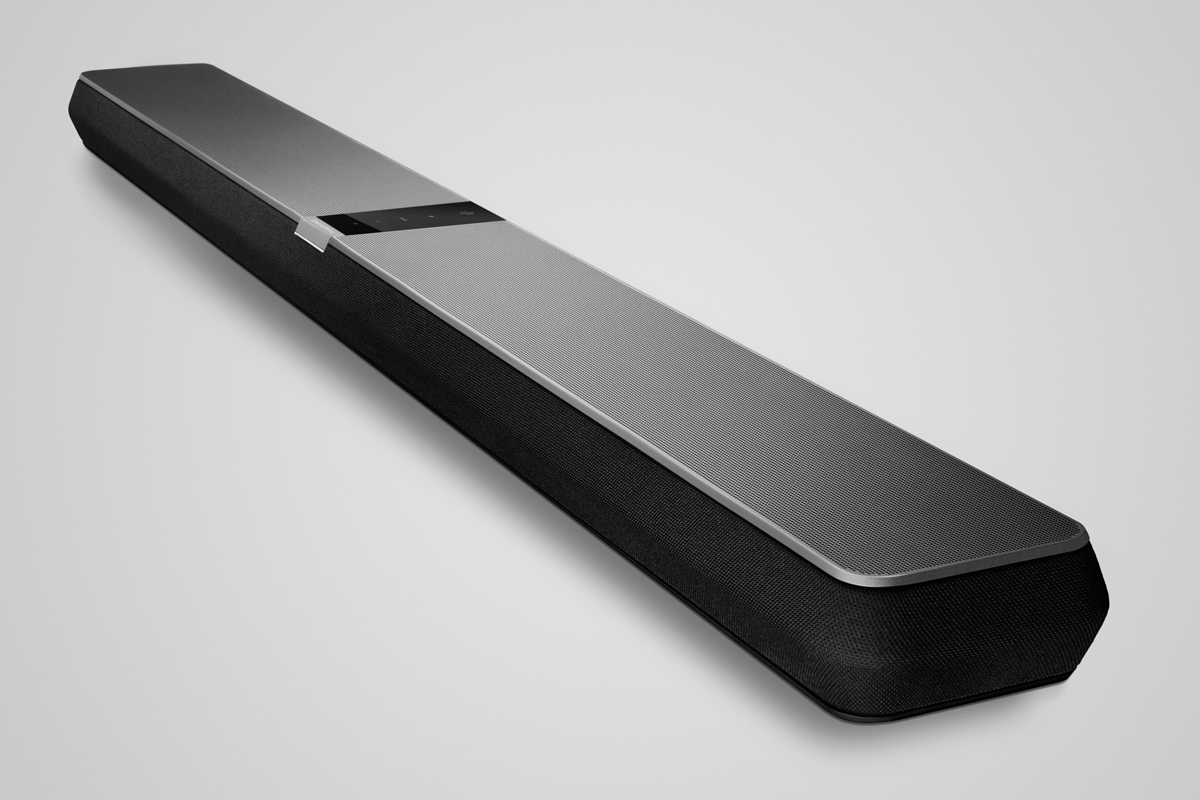
Of course, this low-profile soundbar has limitations in bass extension and dynamics—how could anyone expect otherwise? But the Panorama 3 delivered wonderfully immersive experiences with surround soundtracks on movies and TV, and on spatial audio tracks from Apple Music. And its ability to function as an Amazon Alexa smart speaker was a very useful bonus. For this particular space, the Panorama 3 isn’t just a great compromise. It’s close to ideal.
I suspect there are a great many people who’d like to enjoy immersive audio in a small space but can’t accommodate a full-blown surround setup. If you’re one of these, you should definitely check out the Panorama 3.
. . . Gordon Brockhouse
Associated Equipment
- Active speakers: SVS Prime Wireless Pro.
- Display: Samsung QN50LS003 50″ UHD TV “The Frame.”
- Sources and control devices: Apple Mac Mini (M1, 2020) running Roon Core 2.0, Apple iPhone 8 and Google Pixel 4a 5G smartphones.
- Network: Google Wifi four-node mesh network.
Bowers & Wilkins Panorama 3 Soundbar
Price: $999.
Warranty: Two years, parts and labor.
B&W Group
Dale Road
Worthing BN11 2BH
United Kingdom
Phone: +44 1903 221800
Email:
Website: www.bowers-wilkins.com
Bowers & Wilkins North America
5541 Fermi Court
Carlsbad, CA 92008
United States
Phone: (800) 370-3740





